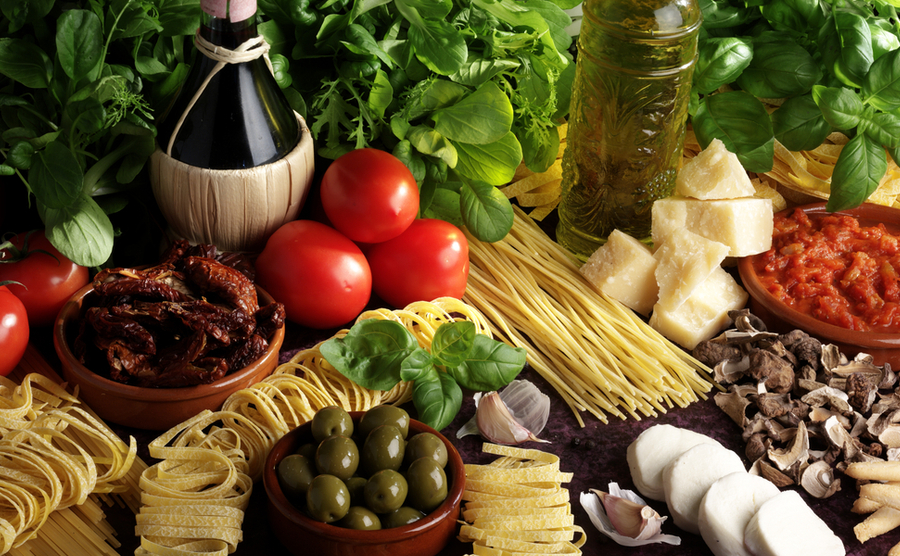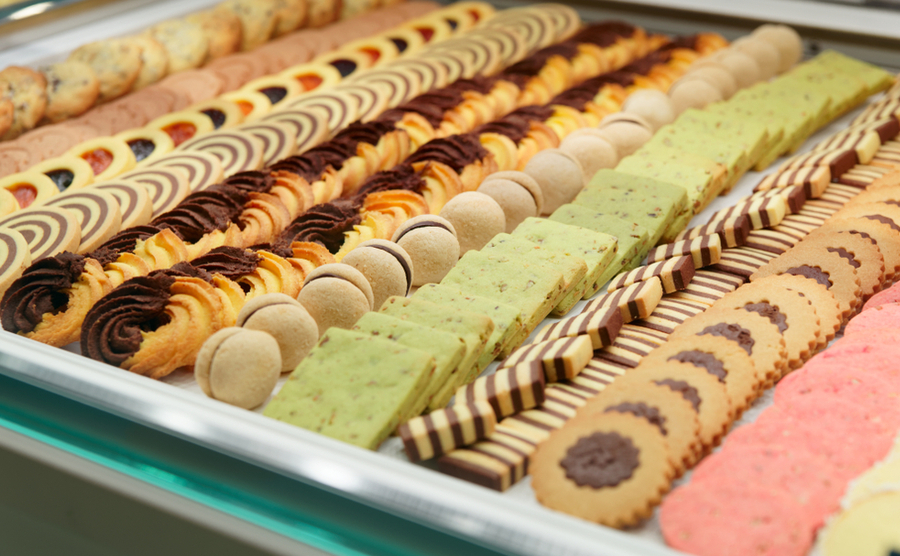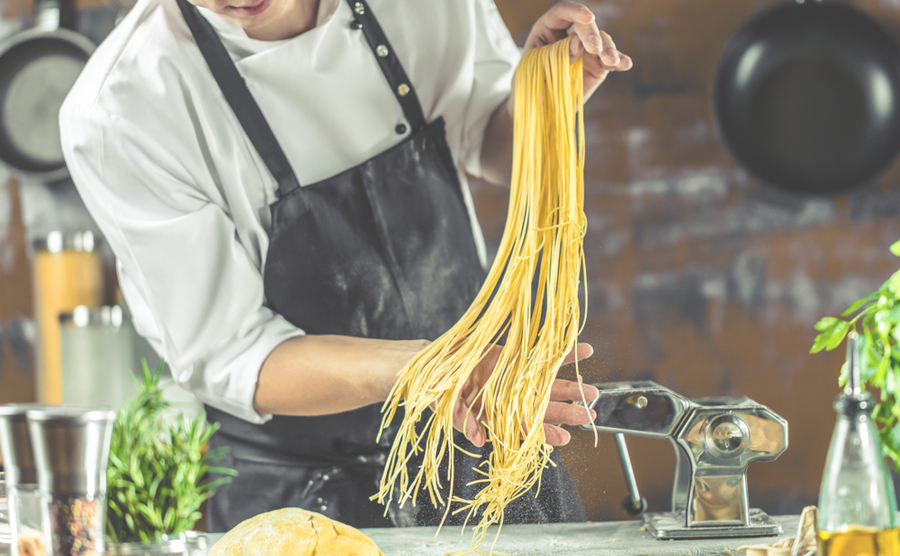Pizza, gelato, pasta, espresso – these are just a few iconic foods that Italy is known for but the country itself is synonymous with great food.
Italian cuisine is renowned around the world for its rich flavors, fresh ingredients, and innovative combinations. Italians are passionate about their food, and it’s no wonder why. With a bounty of quality local produce available at every turn, it’s no wonder that Italians cannot live without certain foods. From fresh seafood to artisanal cheeses, Italian cuisine is a celebration of the country’s abundant natural resources. In this article, we’ll explore some of the foods that Italians simply can’t live without and highlight the importance of quality, locally sourced ingredients in Italian cooking.

A tabletop filled with fresh Italian ingredients
Seasonal fruit and vegetables
Italians food is often made with fresh local ingredients that are in season. This is what makes the Italian diet so healthy, as seasonal fruit and vegetables are higher in the nutrients. For example, root vegetables are good in the cold months and greens in the spring. Oranges and clementines ripen in the winter, just when you need the extra vitamin C.
At first you may be disappointed that you can’t get all the vegetables and fruit you love. But when you taste a fresh sun-ripened tomato, you soon grow to appreciate seasonal is best. Like the first signs of spring weather, it’s great to feel excited about seeing the first cherries. Shortly after, you will see them setting up the melon stalls around town. That’s when you know that summer has truly arrived.
Find homes in Italy via our property portal.
Pasticceria goodies
When invited to a friend’s house for lunch, if you want a tray of biscuits or cakes to take as a gift, then better to go to a bakery or Pasticceria. Get there very early to see the best selection, especially at Easter time.
They usually sell them on a tray and wrap them nicely with a ribbon. The price is calculated by weight. However, if you know how much you want to spend, then tell the assistant and they’ll select the correct size tray for approximately that price.
You should note that in summer, places that sell cakes over the cooler months often switch to selling ice-cream and big tortes and cheesecakes out of the freezer. These are usually gift boxed. If you pass one on a Sunday morning, you’ll see people coming out carrying the boxes, ready to take to Nonna’s house.

Biscotti in an Italian patisserie
Biscuits
Go to any large supermarket and you’ll find a whole aisle, just for biscuits. This is because many Italians will have biscuits with hot milk or cappuccino for breakfast. They are usually cereal based and so it is just a different way of eating your breakfast cereal.
Biscuits in Italy usually come in big family size bags, rather than boxes or packets. A popular biscuit with chocolate chips is called Pavesi Gocciole, which has a curved tear drop shape, to make them easy to dunk.
Latte
Italians generally don’t believe in drinking milky drinks after 11am, and never with a meal. They believe that dairy is too heavy, almost a meal in itself, and will mess up your digestion. While on the subject of milk, you should note that if you ask for a “Latte” expecting a milky coffee, you’ll be handed a glass of milk. The pronunciation is different too. Italian “Latte” is pronounced “La-tay”, whereas in England they say “Lar-tay”.

A chef preparing fresh spaghetti
Pasta – but which shape to choose?
There are 350 different pasta shapes in Italy, with regional specialities. Therefore, when you visit a region, you should ask what their pasta shape is, and give it a try. Many Italian families have pasta every lunchtime.
According to statista, Conad supermarkets offer 45 items of durum wheat pasta in its private brand lines, and a further 72 items from other brands. Pasta takes up one whole aisle. They also have a small selection of Gluten-free and egg pasta.
Pasta and gnocchi can also be found in the fridge section of supermarkets. In town you might also find a fresh pasta shop. 500g of gnocchi costs about €2.20 and cooks in just one and a half minutes.
Can I buy tea bags?
If you are a big tea drinker, and have a favourite British brand, bring them with you to Italy. Then, ask all your family and friends to bring them when they visit too. I can’t see any top British brands in the Italian supermarkets, only small boxes of 25 bags, by brands such as Twinings and Sir Winston Tea. You can buy British brands online from British Corner Shop, Amazon Italy, and Richmonds, but they are expensive and there is a shipping charge on top.
However, the tea and coffee section of Italian supermarkets do have a good selection of herbal and fruit teas. If offered a cup of tea, this is most likely what they have in mind. The nearest they might have to an English tea, is an Earl Grey. This explains why Italians give the British a funny look when they mention putting milk in their tea. I’d pull a face too, if someone put milk in a fruit tea.

A typical Italian breakfast
Coffee, coffee and more coffee
Most Italians drink coffee and choose to make it in a Moka Pot, which is used to prepare ground coffee. A moka pot is an Italian stovetop coffee maker that brews coffee by passing boiling water pressurized by steam through ground coffee. They may also have a fancy coffee machine. The bestselling coffee brand in Italy is Lavazza, but there are many others such as Bourbon, illy and Motta. You can buy jars of instant coffee, including Nescafe, but it isn’t a big seller, resulting in it being more expensive.
As going to the café for a coffee is part of the culture in Italy, many people go there instead. Prices are creeping up in touristy locations, but in your average town, you can still get a coffee for €1.20.
Aqua Naturale o Frizzante?
Italian’s drink a lot of water, and even children I have spoken to, say it is their favourite drink. Fizzy drinks are not common in the home, and I have never seen fruit squash. If you are offered a coffee, you will usually be offered a small glass of water with it. You will be asked if you want “Acqua naturale” (still) or acqua frizzante (sparkling).
Bottled water is cheap to buy in supermarkets, but more people are now trying to be ecofriendly. Tap water is drinkable, and most towns have free drinking water taps in the street. You will see people filling up large reusable water bottles. Some towns even have cold water dispensers in the street, with still and sparkling water on offer for a few cents.

Friends cheersing over dinner
Wine
Supermarkets stock a good selection of wines, in a wide price range. There will be many local wines and even the cheaper ones can taste excellent. An even cheaper option is to go direct to a winery, and refill your reusable bottles straight from the pump. You can even buy Prosecco.
Beer
You will find that beer (birra) is cheaper in Italian supermarkets, than in British ones. This is largely due to lower taxes. Excise duty per 330ml beer bottle in GB in 2022 was 37cents, while in Italy it was only 12 cents. Choose an Italian beer such as Moretti and you’ll see an even greater difference in price. Moretti 66cl in Conad costs 1,25 (£1.06), while in Sainsburys it is £2.40.
You might also be interested in:










